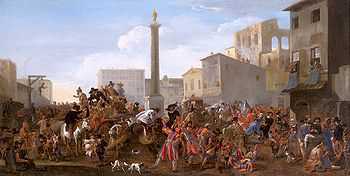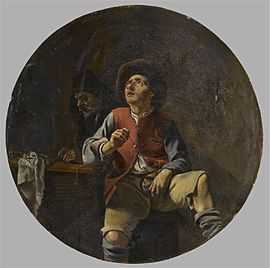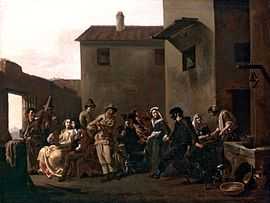Jan Miel
Jan Miel[1] (1599 in Beveren-Waas – 1663 in Turin) was a Flemish painter and engraver who was active in Italy where he initially formed part of the circle of genre painters influenced by Pieter van Laer who are referred to as 'Bamboccianti'. He later developed away from the Bamboccianti style and painted history subjects.
Life

He was probably born in Beveren-Waas, but Antwerp and 's-Hertogenbosch have also been suggested as possible birthplaces. There is no information on his training but it is assumed that it took place in Antwerp.[2] The seventeenth century Italian biographer Giovanni Battista Passeri refers to a training by Anthony van Dyck in Flanders but there is no independent evidence for this statement.[3]
HIs stay in Rome in the period from 1636 to 1658 is documented, but it is possible that he was already there from 1633.[4] In Rome he became a member of the Bentvueghels, an association of mainly Dutch and Flemish artists working in Rome. It was customary for the Bentvueghels to adopt an appealing nickname, the so-called 'bent name'. For Miel two different bent names are documented: Bieco (which means squint in Italian) and Honingh-Bie (which means honey bee and is derived from the surname 'Miele' by which he was known in Italy and which means 'honey' in Italian).[2]
In Rome he also joined the circle of genre painters whose work was influenced by the Dutch painter Pieter van Laer and were referred to as 'Bamboccianti'. The Bamboccianti were mainly Dutch and Flemish artists working in Rome who mostly produced small cabinet paintings or prints of the everyday life of the lower classes in Rome and the surrounding countryside. Jan Miel was a vital force in the development of this new tradition in Rome.[4]
Miel became in 1648 the first northern artist who was admitted to the Accademia di San Luca, a prestigious association of leading artists in Rome. A stay of Miel in Northern Italy of around 1654 is documented. From 1658 until his death he resided in Turin, where he was appointed court painter of Charles Emanuel II, the Duke of Savoy.[5]
Work

Miel’s first dated paintings already show the influence of Pieter van Laer and the Bamboccianti, namely The bowls players and The cobbler, both produced in 1633. In the 1630s he reworked and copied paintings by van Laer.[5]
During the 1640s and 1650s Miel began, just like Michelangelo Cerquozzi, to expand the scope of bambocciate paintings by paying less attention to the surrounding landscape and instead stressing the anecdotal aspects of city and country life. These works were repeatedly used as a model by the Bamboccianti in the second half of the century and by the genre painters working in Rome during the early 18th century.
Miel’s most original contribution to genre painting are his paintings of carnival scenes.
Around 1650 he began to paint less bambocciate and to concentrate on religious paintings for Roman churches executed in a large format. At the same time, Miel also created small paintings with religious subjects for private clients. He collaborated with other artists. He painted the staffage for the veduta (cityscapes or other views) by Viviano Codazzi and Alessandro Salucci and the landscapes of Gaspard Angeluccio and Dughet Angeluccio. He worked with Andrea Sacchi on the painting Urban VIII visits the Church of the Gesù (Galleria Barberini, Rome, 1641).[5][6]
Old auction catalogues mentioned that Miel contributed the staffage to the landscapes of Claude Lorrain during his stay in Rome, but it has not been possible to attribute the human figures in Lorrain's works to Miel.[2]

After moving to Turin in 1658 he decorated the royal hunting lodge at Venaria Reale with large-scale hunting scenes (portions of which are now lost). He painted more and more history paintings which demonstrate an intensification of the classical tendencies already present in the religious paintings of the 1650s. Miel also began to study and copy the works of Raphael and Annibale Carracci, just as he had copied the works of Pieter van Laer at the beginning of his career.[5]
Miel was also a skilled engraver. He designed the frontispiece for La povertà contenta (Rome, 1650) of Daniello Bartoli and the illustrations for De bello belgico (Rome, 1647) of Famiano Strada.[5]
References
- ↑ Name variations: 'Jan Miele', 'Jan Bicke', 'Jan Bike', 'Cavaliere Giovanni Miele', 'Cavaliere Giovanni Milo', 'Cavaliere Giovanni della Vita', 'Petit Jean'; nicknames: 'Bieco' en 'Honingh-bie'
- ↑ 2.0 2.1 2.2 Jan Miel at the Netherlands Institute for Art History (Dutch)
- ↑ Giovanni Miele in: Giovanni Battista Passeri, Vite the pittori, scultori ed architetti che anno lavorato in Roma, Roma, 1772, page 224
- ↑ 4.0 4.1 Jan Miel on Hadrian
- ↑ 5.0 5.1 5.2 5.3 5.4 Ludovica Trezzani. "Miel, Jan." Grove Art Online. Oxford Art Online. Oxford University Press. Web. 12 Feb. 2014
- ↑ The painting Urban VIII visits the Church of the Gesù in the Galleria Barberini in Rome
| Wikimedia Commons has media related to Jan Miel. |
|